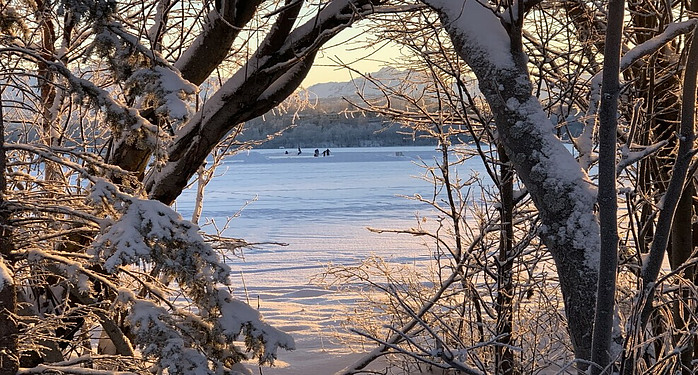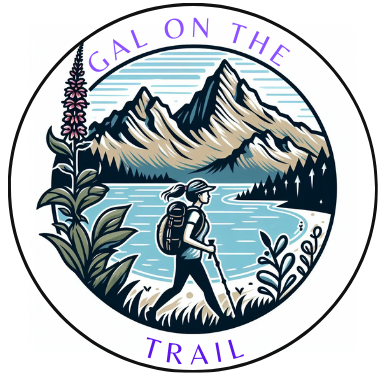
This is the lake near my house that we skate on all winter in Alaska!
Ice skating is a fantastic way for women to boost their physical and mental well-being. Gliding across the ice brings me sheer joy. I hope you can find the fun skating. This activity offers many health benefits. My favorite place to skate is on frozen lakes. I know I am spoiled growing up in Alaska where we have over 3 million lakes,. When you have MANY months of winter, it is best to embrace the weather and head outdoors. Growing up, there was a lagoon by my house that I could walk to for skating. The city often hot-mopped it for the community to enjoy. Over the last few years, the city has hosted events and brought out burn barrels to warm cold hands and hot chocolate for skaters to enjoy. Skating is such a fun low-impact exercise! They have also added a hockey rink side so people can come down and play pick-up games.
Heart-Healthy Glides on Ice:
Ice skating can be tailored to any fitness level. You can go as fast or as slow as you want. Any way you choose to glide, it will be a cardio boost! The movement around the the ice will pump your blood and boost your circulation as well get your heart rate going. I love that it is an exercise that isn’t pounding on my feet, but rather a smooth glide with low impact on joints.
For a real added cardio workout, I encourage you check out hockey. While, it is not a a sport I play, I know it will build up a sweat for sure. If you see people after a game, you have seen the seat-factor players build up. There are a ton of recreational leagues around for new players to start. I know lots of women that play and the teams are fun and welcoming to all levels. If you don’t want to go all in on a team, just go gran a stick and puck and head to the ice!
Physical and Mental Benefits:
I love to eat calories, so burning them is important for my health. Ice skating sessin are a good calorie burner so don’t feel guilty about drinking lots of hot chocolate. As you skate across the ice you are toning muscles through your movements. Skating is also beneficial for joint health and mobility. I find I don’t think about life’s stressors while skating which is good for stress reduction! Being physical will always help with your mental wellness so I encourage you to check out ice skating!
Learning the Ropes:
Skating can be tricky to learn, I am not going to lie. My top tip if you are headed to a lake to skate is to bring something to sit on while putting on your skates! I have a skate bag pre-packed where I leave lots of supplies in it such as hand warmers, cups for cocoa, a blanket or tarp to sit on, extra socks and a snack.
Making sure you have well-fitted skates will make or break your time on the ice. I always buy skates a tad big so I can fit an extra pair of socks in them. Making sure to lace your skates up correctly is what will make or break a great skating time!
When first learning to skate, be patient it does take some time. I highly recommend a helmet or a thick hat at least. Make sure to wear layers of clothing that are not cotton for warmth and need. If you buy your skates used from someone, I encourage you to take them somewhere to be sharpened. It only costs a few dollars and makes a difference!
- Learn the Basics:
Start with the basics, such as standing on skates, marching in place, and practicing small glides. Focus on building confidence in your balance before attempting more advanced moves. - Take a Lesson:
Consider taking lessons from a qualified instructor. They can provide valuable guidance on proper technique, balance, and maneuvering, accelerating your learning curve. - Practice Regularly:
Like any skill, ice skating improves with practice. Dedicate time to regular skating sessions to build strength, coordination, and confidence on the ice.
Safety on the Ice:
Prevention is the best strategy for staying safe in the outdoors. Before venturing onto frozen lakes or ponds, always check the thickness of the ice. Avoid areas with visible cracks, flowing water, or areas near the shore where ice may be weaker. If in doubt, it’s safer to stay off the ice. Surviving a fall through ice requires a combination of preparation, knowledge, and swift action. By staying calm and following these steps, you can increase your chances of safely getting out of the water and preventing further danger.
I want to star by saying I have not been trained nor am I an expert on ice safety. I am sharing what I have learned about the topic. Falling through the ice in a lake can be a very scary and a dangerous situation. Knowing how to respond can significantly increase your chances of survival. Below are the important steps to take if you find yourself in such an emergency:
- Stay Calm: Easier said than done, I know! As hard as it may be, try to stay calm. Panic can lead to poor decision-making and you need your energy to get out of the frigid water.
- Don’t Remove Clothing: The layers of clothing act as insulation, providing some protection against the cold water. Try staying as dry as possible.
- Keep Your Hands on the Ice Shelf: Extend your arms onto the unbroken ice. This can help distribute your weight and may prevent further ice breakage.
- Kick Your Legs: Use a steady and controlled kicking motion to move yourself toward the edge of the ice. Try to keep your body as horizontal as you can to balance your weight evenly.
- Attempt to “Swim” Onto the Ice: Once you are near the edge, try to “swim” onto the ice by using your arms. Try to pull yourself up while kicking your legs. Kick like you have never kicked before!
- Roll Away from the Hole: Now that you are on the ice, roll away from the hole to distribute your weight and minimize the risk of breaking through again.
- Crawl to Safety: Quickly and safely, crawl on your stomach or stay low to the ground to reduce the risk of encountering more thin ice. Aim yourself towards the shore as quickly and safely as possible.
- Signal for Help: If there are other people around, call for help. If you can whistle, do so to attract attention. As I type this, I can’t help but picture Jack and Rose in the Titanic movie when they are in the cold water!
- Call for Emergency Assistance: When you are off the ice, call emergency services immediately. Even if you feel okay, the exposure to cold water can lead to hypothermia, which you may not feel right away.
- Get to Warmth Quickly: Immediately change into dry clothing. Seek shelter and warmth to prevent hypothermia. If you don’t have dry clothes, cover yourself with blankets or anything else that can provide insulation. Make sure you do everything you can to warm-up.
Remember, prevention is the best strategy. Before venturing onto frozen lakes or ponds, always check the thickness of the ice. Avoid areas with visible cracks, flowing water, or areas near the shore where ice may be weaker. If in doubt, it’s safer to stay off the ice. Surviving a fall through ice requires a combination of preparation, knowledge, and swift action. By staying calm and following these steps, you can increase your chances of safely getting out of the water and preventing further danger.
The most important thing about ice skating is to have fun! Skating is a great social outdoor activity where you can skate and talk with others. It is not too expensive as far as sports go and it is good for your mental and physical health. I encourage you to lace up those skates and head outdoors!

